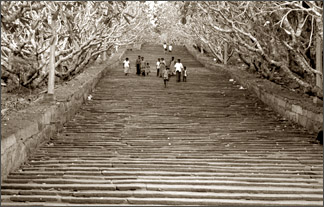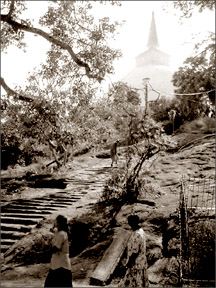Mihintale - spiritual tranquillity
 Eight miles east of Anuradhapura, close to the Anuradhapura -
Trincomalee Road is situated the "Missaka Pabbata" which is 1000 feet in
height and is one of the peaks of a mountainous range. Though this was
called Cetiyagiri or Sagiri, it was popularly known as Mihintale - the
cradle of Buddhism in Sri Lanka. Eight miles east of Anuradhapura, close to the Anuradhapura -
Trincomalee Road is situated the "Missaka Pabbata" which is 1000 feet in
height and is one of the peaks of a mountainous range. Though this was
called Cetiyagiri or Sagiri, it was popularly known as Mihintale - the
cradle of Buddhism in Sri Lanka.
Thera Mahinda came to Sri Lanka from India on the Fullmoon Day of the
month, of Poson and met King Devanampiyatissa and the people, and
preached the doctrine. The traditional spot where this meeting took
place is revered by the Buddhists of Sri Lanka.
Therefore in the month of Poson, Buddhists make their pilgrimage to
Anuradhapura and Mihintale.
From ancient times a large number of large steps were constructed to
climb Mihintale. It is stated that King Devanampiyatissa constructed a
vihara and 68 caves for the bhikkhus to reside in. At Mihintale there
gradually grew a number of Buddhist viharas with all the dependent
buildings characteristic of monasteries of that period.
At the foot of the mountain are the ruins of a hospital, medical bath
(or stone canoe in which patients were immersed in medicinal oil) a
stone inscription and urns belonging to the ancient period have been
unearthed.
Between the hospital and the steps leading to the rock are the ruins
of a large monastery.
|

Ambasthala Dagaba |
On the floors of the square building which is 125 feet on one side,
are beautiful carvings and also are stone balustrades and guard stones.
As this side is precipitous, the steps are on the eastern side of the
slope, spacious and in 4 sections.
The stairway has 1840 steps made of granite, leading to the summit.
At the end of the first set of steps on the right side of the plain, is
a small mountain peak. On this is situated the most famous Kantaka
Cetiya. Heinz E Mller-Dietz (Historia Hospitalium 1975) describes
Mihintale Hospital as being perhaps the oldest in the world.
It is stated that King Suratissa may have built this Stupa. The
Pesavalalu and the frontispiece have been preserved to a great extent.
On the four sides of the stupa are frontispieces. These and the altar
are decorated with figures of dwarfs and elephants.
The stupa has a circumference of 425'1/2", and the ruins of the stupa
are 40 ft in height. It is said that the monks would have resided in the
caves close to the stupa. As this stupa was renovated by King Lajjitissa,
there is no doubt that this belongs to the 1st century B.C.
The Refectory
The Courtyard at Mihintale is situated at the end of the third flight
of steps. To the left of the courtyard is the refectory. The quadrangle
62 feet in length and 25 ft in breadth is surrounded by the storeroom.
Since a part of a pipe line has been discovered here, it can be
concluded that a systematic and well planned pipe borne scheme was
provided. Two stone troughs can be seen here, which would have been used
to store food close to the refectory.
|

Mihintale stone steps |
On either side of the entrance to a building, are two inscriptions
engraved on two large slabs of granite known as the Mihintale stone
inscriptions. The rules and regulations pertaining to the administrative
purposes of the monastery are engraved on these two stone slabs.
This inscription installed by King Mihindu (956 - 976 AD) contains
records of payments made to the service staff. In the vicinity on
another plain is the meeting hall of the monks. Here the monks met, to
discuss the Dhamma and the Vinaya.
This is an open building which is 62 feet square and was constructed
on 48 stone pillars. In the middle of the hall is a platform with 4
entrances, and to the East of the refectory is a stupa, 88 feet in
circumference. It has not been identified so far.
Ambasthala Dagaba
The Dagaba is situated on the plain close to the peak of the
mountain, and is said to have been built by King Makalantissa. The ruins
show that there has been a house built encircling the stupa.
The Dagaba itself is said to enshrine the relics of the great Apostle
Mahinda.
It is here that King Devanampiyatissa first met Arahant Mahinda.
The traditional spot where this meeting took place is marked by the
Ambasthala Dagaba.
The Cave of Arahant Mahinda
When proceeding from Ambastala dagaba along the narrow road, on the
slope is the cave known as Mihindu Guhawa or the cave of Arahant Mahinda,
where he resided. Out of the caves the most famous and incidentally the
most sacred to Buddhists is this cave with its flattened slab on which
Thera Mahinda was accustomed to rest.
This large stupa known as the Maha Seya is on the summit of the
Mihintale hill, built by King Mahadathika Mahanaga (7-19 AD) the base of
which is 136 ft in diameter. The stupa which was in a dilapidated
condition was completely restored.
Aradhana Gala
This rock which faces Maha Seya is on a summit of a hill. Even during
very windy weather pilgrims do not fail to visit this rock, which has
iron railings to help them to climb.
The Naga Pokuna Passing Ambasthalaya on the western side are a flight
of steps.
When going down the steps one could see the Naga Pokuna. This has
been constructed by King Agbo I and its name is derived as there are
figures of snakes with their hoods spread out in the background and is
one of the most famous ponds.
Kaludiya Pokuna
Is also one of the famous ponds at Mihintale. The name is derived
from the fact that the water in the pond appears to be black in colour.
It is believed that on new moon day Kalu Buddha Rakkhita Thera sat
under the Thimbiriya tree, close to the Kaludiya Pokuna, preached on a
sermon based on Kalakarama Sutta.
The word "Kalu" means black. The word "diya" means water, and the
word "pokuna" means pond.
Web
|
